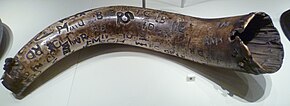
Back Border Reivers (Bande) German Border Reivers French Border Reivers Italian Набеги в англо-шотландском пограничье Russian
This article possibly contains original research. (October 2023) |


Border reivers were raiders along the Anglo-Scottish border. They included both Scottish and English people, and they raided the entire border country without regard to their victims' nationality. They operated in a culture of legalised raiding and feuding.[1] Their heyday was in the last hundred years of their existence, during the time of the House of Stuart in the Kingdom of Scotland and the House of Tudor in the Kingdom of England.
The term "Border Reiver" is an exonym and anachronistic term used to describe the raiders and bandits who operated along the Anglo-Scottish Border during the late Middle Ages and early modern period. The reivers, as we understand today, emerged in textual and archaeological evidence sometime between 1350 and 1450,[2][3] with their activities reaching their height in the 16th century during the Tudor period in England and the late Stewart period in Scotland.[4] They were infamous for raiding, eliciting protection money ('blackmail'), cattle rustling, and lawlessness, often operating within a framework of legally sanctioned violence. Many crimes, such as theft and feuding, were treated with less severity due to the ancient customs and culture of the Borderlands, which had evolved over centuries to tolerate and even codify such practices.[1]
Although less well-known than Highlanders in Scotland—whom they met and defeated in battle on occasion[5]—the Border Reivers played a significant role in shaping Anglo-Scottish relations.[6] Their activities were a major factor in ongoing tensions between the two kingdoms, and their raids often had international repercussions.[7] There is an emerging historical debate over how great their threat and the extent to which their raids were state-directed rather than purely opportunistic.[3][8][4]
The culture of the Border Reivers—characterised by honour, close family bonds, and self-defence—has been said to influence the culture of the Upland South in the United States. Many Borderers migrated as families to America, where their values are thought to have contributed significantly to the region's social structure and political ideologies, with echoes of their influence persisting even today.[9][10][11]
- ^ a b Neville, Cynthia J. Violence, Custom and Law: The Anglo-Scottish Border Lands in the Later Middle Ages. Edinburgh University Press, Edinburgh, 1998. ISBN 978-0-7486-1073-5.
- ^ Robson, Ralph. The Rise and Fall of the English Highland Clans: Tudor Responses to a Mediaeval Problem. Edinburgh University Press, Edinburgh, 1989. ISBN 978-0-85224-635-4.
- ^ a b Steingraber, Aubrey Maria. Landscape and the Making of the Medieval Anglo-Scottish Border: Power, Place, and Perspective c.1200–c.1500. PhD Thesis, University of York, Department of Archaeology, March 2022.
- ^ a b Fraser, George MacDonald. The Steel Bonnets: The Story of the Anglo-Scottish Border Reivers. HarperCollins, London, 1995. ISBN 978-0-00-272746-5.
- ^ Sadler, John. Flodden 1513: Scotland's Greatest Defeat. Osprey Campaign Series, Osprey Publishing, Oxford, 2006. ISBN 978-1-84176-962-2.
- ^ Boscher, Paul Gerard. Politics, Administration and Diplomacy: The Anglo-Scottish Border 1550–1560. PhD Thesis, University of Newcastle, 1988.
- ^ Moffat, Alastair. The Reivers: The Story of the Border Reivers. Birlinn Limited, Edinburgh, 2007. ISBN 978-1-84158-656-4.
- ^ Robb, Graham. The Debatable Land: The Lost World Between Scotland and England. Picador, London, 2018. ISBN 978-1-5098-3647-0.
- ^ Fischer, David Hackett. Albion's Seed: Four British Folkways in America. Oxford University Press, New York, 1989. ISBN 978-0-19-506905-1.
- ^ McWhiney, Grady, and McDonald, Forrest. Cracker Culture: Celtic Ways in the Old South. University of Alabama Press, Tuscaloosa, 1988. ISBN 978-0-8173-0497-7.
- ^ "How Northern England Made the Southern United States". History Today. 31 October 2019. Retrieved 4 December 2024.